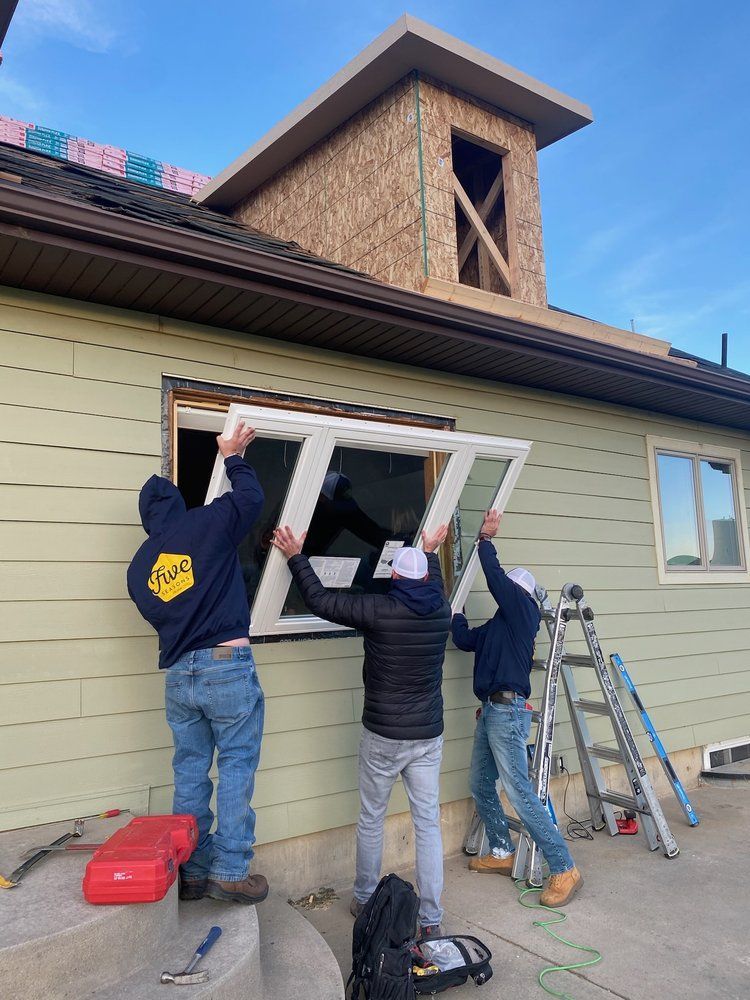To measure for window replacement, measure the width at the top, middle, and bottom of the rough opening, then measure height at the left, center, and right sides. Use the smallest width and height measurements, subtract 1/4 inch from each dimension for proper clearance, and always measure from inside the house for accurate rough opening dimensions.
According to the Window and Door Manufacturers Association, measurement errors account for 78% of window installation problems and warranty claims, with incorrect rough opening measurements being the leading cause of costly project delays and custom manufacturing requirements.
Accurate window measurements are critical for successful replacement projects. Even small measurement errors can result in windows that don't fit properly, leading to air leaks, water infiltration, and expensive custom modifications. Understanding the difference between rough opening measurements and window sizing ensures your replacement windows fit perfectly and perform optimally for decades.
Essential Tools and Preparation
Required Measuring Tools
A quality 25-foot steel measuring tape is essential for accurate window measurements, as cloth or plastic tapes can stretch and provide inconsistent readings. Steel tapes maintain their accuracy over time and provide the precision necessary for window replacement measurements.
Additional tools include a 4-foot level for checking square and plumb conditions, a notepad for recording measurements, and a digital camera or smartphone for documenting existing window conditions. A flashlight helps illuminate measurement areas, particularly in basements or poorly lit spaces where precision is critical.
Safety Considerations and Access
Window measurement often requires accessing upper floors, basements, or challenging locations that demand proper safety precautions. Use stable ladders with proper positioning and have someone assist with measurements when working at height or in awkward positions.
Clear the measurement area of furniture, curtains, and window treatments to ensure unobstructed access to all measurement points. Remove interior trim carefully if precise rough opening measurements are required, noting that this step may require professional assistance to avoid damage.
Step-by-Step Measurement Process
Width Measurements
Measure the width of the rough opening at three points: top, middle, and bottom of the window frame. Take measurements from the inside surfaces of the rough opening, not from exterior trim or siding that may not represent the actual opening size.
Record all three width measurements and use the smallest dimension for ordering purposes. This ensures the replacement window will fit through the narrowest point of the opening. Variations greater than 1/4 inch between measurements may indicate structural issues requiring professional evaluation.
Height Measurements
Measure the height of the rough opening at three points: left side, center, and right side of the window frame. Measure from the bottom of the header (top of the rough opening) to the top of the sill (bottom of the rough opening), avoiding any interior trim or finishing materials.
Use the smallest height measurement for window ordering, applying the same principle as width measurements. Significant height variations may indicate settling, structural movement, or improper original installation that could affect replacement window performance.
Understanding Rough Opening vs. Window Size
Rough Opening Specifications
The rough opening represents the actual framed opening in the wall structure where the window will be installed. This opening must be larger than the window unit itself to allow for proper installation, shimming, and insulation around the window frame.
Standard practice requires the rough opening to be 1/2 inch wider and 1/2 inch taller than the replacement window unit. This clearance allows for proper positioning, squaring, and insulation while accommodating minor variations in framing and window manufacturing tolerances.
Window Unit Dimensions
Replacement windows are manufactured to specific dimensions that fit within standard rough opening sizes. The window unit dimensions include the frame but exclude any exterior trim or installation materials that extend beyond the basic window assembly.
Understanding the relationship between rough opening size and window unit size prevents ordering errors and ensures proper fit. Most manufacturers provide sizing charts that correlate rough opening dimensions with appropriate window unit sizes for various product lines.
Common Measurement Mistakes
Measuring Existing Window Instead of Opening
One of the most frequent errors involves measuring the existing window unit rather than the rough opening dimensions. Existing windows may have settled, shifted, or been improperly sized initially, making their dimensions unreliable for replacement window ordering.
Always measure the rough opening directly when possible, or add appropriate clearance to existing window measurements if rough opening access is limited. Professional contractors often verify rough opening dimensions during installation to confirm proper sizing before installation begins.
Ignoring Square and Plumb Conditions
Assuming window openings are perfectly square and plumb can lead to measurement errors and installation problems. Many older homes have settled or shifted over time, creating openings that are out of square or not properly plumb.
Check diagonal measurements to verify square conditions, and use a level to confirm plumb and level conditions. Document any irregularities for discussion with your window contractor, as significant variations may require opening modifications or custom window sizing.
Special Measurement Considerations
Bay and Bow Window Measurements
Bay and bow windows require complex measurements including individual panel dimensions, overall width and height, and angle specifications for proper manufacturing. These measurements typically require professional expertise due to their complexity and the custom nature of most bay and bow installations.
Document the number of panels, their individual sizes, and the angles between panels when measuring existing bay or bow windows. Professional measurement is often recommended for these specialty windows to ensure accurate replacement specifications and proper installation.
Basement and Egress Window Requirements
Basement windows often serve as emergency egress routes with specific size requirements mandated by building codes. Measure both the rough opening and the well dimensions for basement windows, ensuring replacement windows meet current egress requirements.
Egress windows must provide minimum opening dimensions for emergency exit purposes, and these requirements may differ from the original window specifications. Consult local building codes and consider professional measurement for egress window replacements to ensure compliance.
When to Call Professionals
Complex Measurement Situations
Professional measurement becomes essential for challenging situations including structural modifications, custom window shapes, or installations requiring opening size changes. Experienced contractors have specialized tools and expertise to handle complex measurement scenarios accurately.
Historic homes, log construction, or unique architectural features often require professional measurement expertise to ensure proper window specification and installation. The cost of professional measurement is typically minimal compared to the expense of incorrectly sized windows.
Verification and Quality Assurance
Even accurate DIY measurements benefit from professional verification before placing window orders. Many contractors offer measurement verification services that provide confidence in sizing accuracy and help prevent costly ordering errors.
Professional contractors also understand manufacturer-specific sizing requirements, installation clearances, and local building code considerations that affect window measurements. This expertise ensures optimal window selection and proper installation specifications.
Once you have accurate measurements, planning the timing of your window replacement project becomes crucial for successful completion. For comprehensive guidance on scheduling your window replacement project for optimal results, explore our detailed guide: 🔗Best Window Replacement Timeline in Colorado: Weather Factors & Project Planning

People Also Ask About Measuring for Window Replacement
1. Should I measure from inside or outside the house for window replacement?
Always measure from inside the house for window replacement to get accurate rough opening dimensions. Interior measurements provide direct access to the actual framed opening where the new window will be installed, avoiding complications from exterior trim, siding, or weather-resistant barriers.
Exterior measurements can be misleading because they often include trim, siding overlap, or other finishing materials that don't represent the actual opening size. Interior measurements also allow you to check for square and plumb conditions that affect window installation.
The only exception is when interior access is completely blocked and rough opening dimensions cannot be determined from inside. In these cases, exterior measurements require careful consideration of trim and siding thickness to estimate actual opening dimensions accurately.
2. How much smaller should a replacement window be than the rough opening?
Replacement windows should be approximately 1/2 inch smaller in both width and height than the rough opening dimensions. This provides 1/4 inch clearance on all sides for proper installation, shimming, and insulation around the window frame.
This clearance is essential for squaring the window in the opening, accommodating minor variations in framing, and ensuring proper weathersealing around the entire perimeter. Insufficient clearance can prevent proper installation, while excessive clearance may compromise structural support.
Some window manufacturers specify different clearance requirements, so always verify sizing specifications with your chosen window brand. Professional installers may recommend slightly different clearances based on specific installation conditions or local building requirements.
3. What if my window measurements don't match standard sizes?
Non-standard window measurements may require custom window manufacturing, which typically adds 3-6 weeks to delivery time and increases costs by 15-30% compared to standard sizes. However, many manufacturers offer extensive standard size ranges that accommodate most residential openings.
Before ordering custom windows, verify your measurements and consider whether minor opening modifications might allow standard window sizes. Sometimes adjusting the rough opening by 1-2 inches can accommodate standard windows at significant cost savings.
If custom sizing is necessary, work with experienced contractors who understand custom window specifications and installation requirements. Custom windows often require more precise installation techniques and may have different warranty considerations than standard products.
4. Can I use my old window measurements for replacement windows?
Using old window measurements is risky because existing windows may have settled, shifted, or been improperly sized initially. Always verify rough opening dimensions directly rather than relying on existing window measurements for replacement window ordering.
Older windows may also have different sizing standards than current replacement windows. Window manufacturing standards and sizing conventions have evolved over time, making historical window dimensions potentially incompatible with modern replacement products.
If rough opening access is limited, add appropriate clearance to existing window measurements and verify dimensions with your contractor before ordering. Professional measurement verification is particularly important when relying on existing window dimensions for replacement specifications.
5. How do I measure windows that are out of square?
For out-of-square windows, measure width at the top, middle, and bottom, then measure height at the left, center, and right sides. Use the smallest measurements for both width and height to ensure the replacement window fits through the most restrictive dimensions.
Check diagonal measurements to determine how far out of square the opening is. If diagonal measurements differ by more than 1/4 inch, the opening may require modification or custom window sizing to ensure proper fit and performance.
Severely out-of-square openings may need professional evaluation to determine whether opening modification or custom window manufacturing provides the best solution. Some contractors can adjust openings to accommodate standard window sizes, potentially saving costs compared to custom windows.
Our Take
At Five Seasons Windows & Doors, we've seen countless projects delayed or complicated by measurement errors, which is why we always verify measurements before ordering windows, even when homeowners provide their own measurements. Accurate measurement is the foundation of successful window replacement, and small errors can have significant consequences for project timeline and costs.
We typically recommend professional measurement for most replacement projects, not because homeowners can't measure accurately, but because our experience helps identify potential issues before they become problems. We understand manufacturer-specific sizing requirements, local building codes, and installation considerations that affect measurement specifications.
Our measurement process includes documenting existing conditions, checking for structural issues, and verifying rough opening dimensions to ensure optimal window selection. This comprehensive approach prevents surprises during installation and ensures replacement windows perform as expected for decades to come.
Final Takeaway
Accurate window measurement requires understanding the difference between rough opening dimensions and window unit sizes, using proper tools and techniques, and avoiding common measurement mistakes. While DIY measurement is possible with careful attention to detail, the consequences of errors often make professional verification worthwhile.
The key to successful window measurement lies in measuring rough opening dimensions rather than existing windows, taking multiple measurements at different points, and using the smallest dimensions for ordering purposes. These practices ensure replacement windows fit properly and allow for optimal installation techniques.
When in doubt, consult with professional contractors who understand the relationship between measurements, window sizing, and installation requirements. The modest cost of professional measurement services is minimal compared to the expense and delays caused by incorrectly sized windows, making expert verification a wise investment for most replacement projects.
Get Started Today
Five Seasons Windows & Doors is Colorado’s top-rated local window company with 230+ 5-star reviews. We offer expert advice, no-pressure quotes, and flexible project options — including phased installs. Schedule your consult today.




